 W
WAdam and Eve is a pair of oil-on-panel paintings by Hans Baldung Grien, dating to around 1520 and now in the Uffizi in Florence. It is a copy of a pair of works on the same subject by Albrecht Dürer, produced in 1507 and now in the Museo del Prado.
 W
WAllegory to the Element Earth is a painting by the Venetian Renaissance artist Leandro Bassano of about 1580, now in The Walters Art Museum, Baltimore.
 W
WAllegory of the Planets and Continents is a 1752 painting by Italian artist Giovanni Battista Tiepolo. Done in oil on canvas, the allegorical work uses human figures to represent members of the Greco-Roman pantheon, the planets, and four continents. The painting is an elaborate oil sketch made by Tiepolo in preparation for rendering a similar, larger version of his scene.
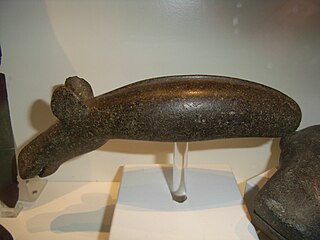 W
WThe Alunda moose or the Alunda axe is a Neolithic stone axe c.2000 B.C.that was found during the excavation of a ditch in Norrlövsta i Alunda parish, Östhammar Municipality, Uppland in 1920. The Alunda moose is considered one of the most beautiful animal sculptures of the Nordic neolithic and is a 21 cm. ceremonial axe carved from greenish black diorite. One side is shaped like a moose head. The sculpture was realized in a naturalistic and elegant manner. The axe has a shaft hole but only had a symbolic function since the hole is not completely bored through and the axe hasn't been used in battle. The axe may originate from Karelia where similar animal depictions are known. It is displayed in the Swedish History Museum.
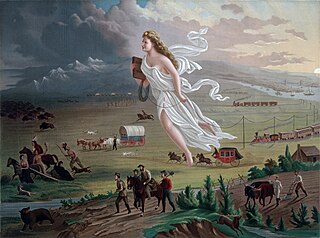 W
WAmerican Progress is an 1872 painting by John Gast, a Prussian-born painter, printer, and lithographer who lived and worked most of his life in Brooklyn, New York. American Progress, an allegory of Manifest Destiny, was widely disseminated in chromolithographic prints. It is now held by the Autry Museum of the American West in Los Angeles, California.
 W
WAnimals in Pools is a series of fountains and bronze sculptures of Pacific Northwest animals, designed by American artist Georgia Gerber and located in Portland, Oregon, in the United States. The series was installed in 1986 as part of the renovations associated with construction of the MAX Light Rail. Funded by the Downtown Merchants Local Improvement District, TriMet and the United States Department of Transportation, the sculptures were presented as gifts to the city and remain part of the collection of the City of Portland and Multnomah County Public Art Collection courtesy of the Regional Arts & Culture Council.
 W
WArtemis and the Stag is an early Roman Imperial or Hellenistic bronze sculpture of the ancient Greek goddess Artemis. In June 2007 the Albright-Knox Art Gallery placed the statue into auction; it fetched $28.6 million, the highest sale price of any sculpture at the time.
 W
WThe Big Elk, also known as Storelgen, is the world's second-tallest sculpture of a moose. Moose are often called elk in Europe. It is near the village of Atna in Stor-Elvdal, Hedmark, Norway. It held the title of the tallest moose sculpture for 4 years, from its completion in October 2015 until October 2019.
 W
WThe Christ between Four Angels and the Instruments of the Passion is a painting by the Italian Renaissance master Vittore Carpaccio, executed in 1496 and now housed in the Civici musei e gallerie di storia e arte of Udine, northern Italy.
 W
WExpulsion from the Garden of Eden was painted in 1828 by English-born American painter Thomas Cole. It belongs to the collection of the Museum of Fine Arts, Boston and is on display in their Waleska Evans James Gallery. This landscape painting exemplifies the style of the Hudson River School, which was a group of American landscape painters that Thomas Cole is credited with founding. On the lower left part of the cliff, Cole signed his name as "T Cole".
 W
WColonel Acland and Lord Sydney: The Archers is an oil-on-canvas painting by Sir Joshua Reynolds undertaken between 1769 and 1770. The artwork depicts the two aristocrats Colonel John Dyke Acland and Lord Sydney (1732–1774), a diplomat. Reynolds began the work in 1769, and completed it the next year. In 1769 Reynolds had become the first president of the new Royal Academy. In September 2005, the Tate purchased the painting for more than £2.5 million, equivalent to US$4.4 million.
 W
WThe Darlington Memorial Fountain is a gilded bronze statue by C. Paul Jennewein. It is located at Judiciary Park at 5th Street and D Street, Northwest, Washington, D.C., in the Judiciary Square neighborhood.
 W
WThe Death of Actaeon is a late work by the Italian Renaissance painter Titian, painted in oil on canvas from about 1559 to his death in 1576 and now in the National Gallery in London. It is very probably one of the two paintings the artist stated he had started and hopes to finish in a letter to their commissioner Philip II of Spain during June 1559. However, most of Titian's work on this painting possibly dates to the late 1560s, but with touches from the 1570s. Titian seems never to have resolved it to his satisfaction, and the painting apparently remained in his studio until his death in 1576. There has been considerable debate as to whether it is finished or not, as with other very late Titians, such as the Flaying of Marsyas, which unlike this has a signature, perhaps an indication of completion.
 W
WDiana and a Nymph Surprised by a Satyr is a 1622-1627 oil on canvas painting resulting from a collaboration between Anton van Dyck and Frans Snyders. It entered the Spanish royal collections and was first recorded at the new Palacio Real de Madrid, next to Guardajoyas. It remained there until 1747, when it moved to infante don Luis's room at the Palacio del Buen Retiro.
 W
WDiana and Callisto is a painting produced by Peter Paul Rubens between 1637 and 1638. It was one of a number of paintings commissioned from the artist by Philip IV of Spain for his new hunting lodge, the Torre de la Parada. It measures 202 by 303 cm and is now in the Museo del Prado. It shows Diana and Callisto.
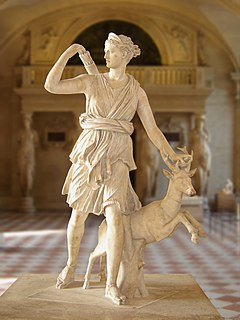 W
WThe Diana of Versailles or Artemis, Goddess of the Hunt is a slightly over-lifesize marble statue of the Roman goddess Diana with a deer. It is currently located in the Musée du Louvre, Paris. The statue is also known as Diana with a Doe, Diana Huntress, and Diana of Ephesus. It is a partially restored Roman copy of a lost Greek bronze original attributed to Leochares, c. 325 BC.
 W
WElk, also known as the David P. Thompson Fountain, David P. Thompson Monument, Elk Fountain, or the Thompson Elk, was a historic outdoor fountain and bronze sculpture by American artist Roland Hinton Perry. The statue was donated to the city of Portland, Oregon, United States, in 1900 for display in Downtown Portland's Plaza Blocks. It is owned by Regional Arts & Culture Council (RACC). The monument became a gathering place for demonstrations by George Floyd protesters, who lit several fires in the troughs along the base in July 2020. The undamaged bronze elk statue was removed for cleaning and safekeeping on July 2, 2020. The stone fountain was removed on July 17, 2020 after RACC determined there was severe damage to the stone and basin of the fountain.
 W
WElk Bath is a wildlife photograph by John McColgan, a fire behavior analyst working for the Alaska Fire Service division of the Bureau of Land Management. It was taken on August 6, 2000, on the East Fork of the Bitterroot River on the Sula Complex, Bitterroot National Forest, Montana, United States, and is also sometimes known by the title, Bitterroot Forest Fire or, more vaguely, Montana Fire. When NASA featured it in its online Astronomy Picture of the Day series, it was called Fire on Earth. The image shows two Rocky Mountain elk seeking protection from a wildfire by standing in the river.
 W
WElk's Head of Huittinen is a Mesolithic moose head figurine of soapstone found in 1903 from Huittinen in the province of Satakunta, Finland. The sculpture is dated to between 8,000 and 9,000 years ago. It is placed in the permanent exhibition of National Museum of Finland in Helsinki. Replicas are displayed in the Museum of Huittinen and in the sculpture collection of University of Helsinki. Elk's Head is most likely the best-known archaeological artifact in Finland.
 W
WFate of the Animals is a painting by Franz Marc created in 1913. It is oil on canvas. This work contrasts most of Marc's other works by presenting animals in a brutal way rather than depicting them in a peaceful manner. Marc's strong ties with animals as his subjects remains uncertain, but it is predicted to stem from his childhood dog. Fate of the Animals remains one of Marc's most famous pieces and displays Der Blaue Reiter style that he co-founded with Wassily Kandinsky. The painting currently resides in the Kunstmuseum in Basel, Switzerland.
 W
WForest Idyl is a bronze statue created in 1924 by Albin Polasek while he was head of the Sculpture Department at the Art Institute of Chicago. There are several copies of three versions of the sculpture, the locations of which are Brookgreen Gardens in South Carolina; three in Winter Park, Florida, at the Albin Polasek Museum & Sculpture Gardens and at City Hall; and in Muncie, Indiana, at Ball State University.
 W
WThe Fountain of Diana, also known as Diana of Anet and Diana with a Stag, is a marble Mannerist sculpture of the goddess Diana, representing Diane de Poitiers. It was created c. 1549 to be the central ornament of a grand fountain in a courtyard of Diane de Poitier's Château d'Anet, but today is in the Louvre, Room 15b on the ground floor of the Richelieu Wing. Long believed to be the work of Jean Goujon, the identity of the sculptor is now considered uncertain, although Benvenuto Cellini, Germain Pilon, Pierre Bontemps, and Ponce Jacquiot have in turn been suggested.
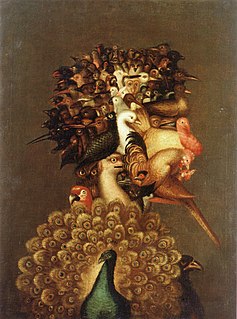 W
WThe Four Elements is a series of four oil paintings by the Italian artist Giuseppe Arcimboldo which were created in 1566, during the Renaissance, for Maximilian II, Holy Roman Emperor. The paintings depict human faces in profile made up from different animals or objects. Air is represented by birds, Fire by burning wood and cannons, Earth by land animals and Water by marine creatures. The series attempts to express the creation of harmony from chaos by the careful arrangement of the wild animals to form portraits whilst also praising Maximilian by suggesting that he is a ruler who controls even the four primal elements.
 W
WThe Garden of Earthly Delights is the modern title given to a triptych oil painting on oak panel painted by the Early Netherlandish master Hieronymus Bosch, between 1490 and 1510, when Bosch was between 40 and 60 years old. It has been housed in the Museo del Prado in Madrid since the year 1939.
 W
WThe Gundestrup cauldron is a richly decorated silver vessel, thought to date from between 200 BC and 300 AD, or more narrowly between 150 BC and 1 BC. This places it within the late La Tène period or early Roman Iron Age. The cauldron is the largest known example of European Iron Age silver work. It was found dismantled, with the other pieces stacked inside the base, in 1891 in a peat bog near the hamlet of Gundestrup in the Aars parish of Himmerland, Denmark. It is now usually on display in the National Museum of Denmark in Copenhagen, with replicas at other museums; during 2015–16 it was in the UK on a travelling exhibition called The Celts.
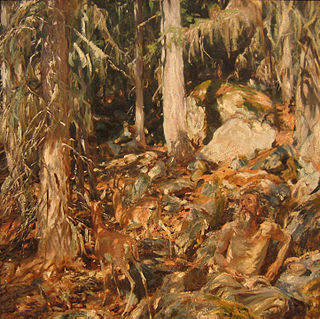 W
WThe Hermit is a 1908 painting by John Singer Sargent. It is part of the collection of the Metropolitan Museum of Art.
 W
WThe Hermit Saints is a religious oil on panel painting displayed as a triptych, meaning it is one whole painting composed of three separate scenes. This artwork was made by the Renaissance artist Hieronymus Bosch, dating from 1493. The entirety of the triptych painting measures 86 x 60 cm. This artwork is currently being housed at the Gallerie dell'Accademia, Venice.
 W
WThe Hunt in the Forest is a painting by the Italian artist Paolo Uccello, made around 1470. It is perhaps the best-known painting in the Ashmolean Museum, Oxford, England.
 W
WThe Hunt of the Unicorn or the Unicorn Tapestries is a series of European tapestries dating from the late Middle Ages. This series of seven tapestries now in The Cloisters in New York was possibly made – or at least designed – in Paris at the turn of the sixteenth century. They are one of the canonical works of Late Middle Ages/Early Renaissance art and show a group of noblemen and hunters in pursuit of a unicorn through an idealised French landscape. The tapestries were woven in wool, metallic threads, and silk. The vibrant colours, still evident today, were produced from dye plants: weld (yellow), madder (red), and woad (blue).
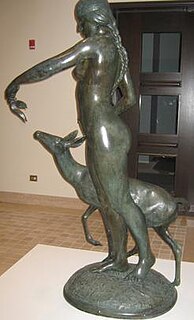 W
WIndian Maiden and Fawn is a 1917–1924 sculpture by Alexander Phimister Proctor.
 W
WThe Kill - Deer Hunting in the Grand Jura Forests was an 1857 painting by Gustave Courbet. It was his first work on a hunting theme and is now in the Museum of Fine Arts, Boston.
 W
WKilling a Deer or A Deer Hunt – The Kill, is a very large picture, representing a hunting scene, painted in 1867 by Gustave Courbet. The picture is currently on display in the Musée d'Orsay of Paris.
 W
WLake with Dead Trees, also known as Catskill, is an oil on canvas painting completed in 1825 by Thomas Cole. Depicting a scene in the Catskill Mountains in southeastern New York State, this work is one of five of Cole's 1825 landscapes to found the mid-19th century American art movement known as the Hudson River School.
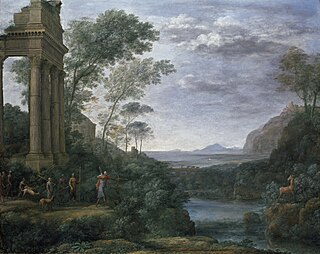 W
WLandscape with Ascanius Shooting the Stag of Sylvia is a painting of 1682 in oil on canvas by Claude Lorrain, a painter from the Duchy of Lorraine who spent his career in Rome. It was painted in Rome for Prince Lorenzo Onofrio Colonna (1637–1689), Claude's most important patron in his last years, and is now in the Ashmolean Museum, Oxford. It is signed, dated with the year, and inscribed with the subject, as Claude sometimes did with his less common subjects.
 W
WThe Love Embrace of the Universe, the Earth (Mexico), Myself, Diego, and Señor Xolotl is a 1949 painting by Frida Kahlo. Created in Mexico, the 70cm x 60.5cm painting was painted with oil on Masonite.
 W
WMac the Moose is a steel and concrete sculpture of a moose in Moose Jaw, Saskatchewan. It is on the grounds of Moose Jaw's visitors' center, on the corner of E Thatcher Drive and the Trans-Canada Highway. It is claimed to be the world's largest moose at 10.36 metres (34.0 ft) tall and a weight of approximately 10 long tons (10,000 kg).
 W
WThe Maine Centennial half dollar is a commemorative coin struck in 1920 by the United States Bureau of the Mint, in honor of the anniversary of Maine's admission to the Union on March 15, 1820. It was sculpted by Anthony de Francisci, following sketches by artist Harry Cochrane, from Monmouth, Maine.
 W
WThe Monarch of the Glen is an oil-on-canvas painting of a red deer stag completed in 1851 by the English painter Sir Edwin Landseer. It was commissioned as part of a series of three panels to hang in the Palace of Westminster in London. As one of the most popular paintings throughout the 19th century, it sold widely in reproductions in steel engraving, and was finally bought by companies to use in advertising. The painting had become something of a cliché by the mid-20th century, as "the ultimate biscuit tin image of Scotland: a bulky stag set against the violet hills and watery skies of an isolated wilderness", according to the Sunday Herald.
 W
WMoose (W-02-03) is a sculpture of a moose by John Kearney on the Magnificent Mile in front of 401 North Michigan and across Michigan Avenue from the Wrigley Building in the Near North Side community area of Chicago, Illinois. It is a welded steel work of art created in between 2002 and 2003. Its dimensions are 8 ft 9 in (2.67 m) x 4 ft 2 in (1.27 m) x 9 ft 0 in (2.74 m)
 W
WMoose in the City was a project in the year 2000, by the City of Toronto government in which 326 life-sized moose sculptures were placed throughout the city and decorated by local artists.
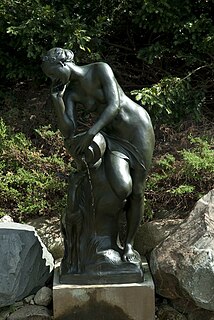 W
WNymph and Fawn is a public artwork by American artist Isidore Konti and located within the Oldfields–Lilly House & Gardens estate on the grounds of the Indianapolis Museum of Art (IMA), near Indianapolis, Indiana. Created in 1917, the bronze sculpture is also a working fountain. It portrays a female nude pouring water from an urn while standing beside a small fawn.
 W
WThe Nymph of Fontainebleau, also known as the Nymph of Anet or the Nymph with the Stag, is a c. 1543 bronze relief, created by the Italian sculptor Benvenuto Cellini for the Château de Fontainebleau in France. It features a long-limbed reclining nude female nymph with a stag, wild boars, dogs, and other animals. It was Cellini's first large scale bronze casting.
 W
WThe quarter, short for quarter dollar, is a Canadian coin worth 25 cents or one-fourth of a Canadian dollar. It is a small, circular coin of silver colour. According to the Royal Canadian Mint, the official name for the coin is the 25-cent piece, but in practice it is usually called a "quarter", much like its American counterpart. In French, it is called a caribou or trente sous. The coin is produced at the Royal Canadian Mint's facility in Winnipeg, Manitoba.
 W
WRebirth, nicknamed "Deer Baby" and "Twilight Zone Bambi", was a proposed outdoor sculpture by American artist Seyed Alavi, considered for installation at the MAX Orange Line's Southeast Park Avenue MAX Station in Oak Grove, an unincorporated area neighboring Milwaukie in Clackamas County, Oregon, in the United States. The design of the unfinished creative work, which featured a 30-foot (9.1 m) deer with a child's face, was met with a mixed reception. Unable to meet TriMet's standards and remain under budget, in November 2011 Alavi withdrew his design from the project.
 W
WRichmond Park, in the London Borough of Richmond upon Thames, was created by Charles I in the 17th century as a deer park. The largest of London's Royal Parks, it is of national and international importance for wildlife conservation. The park is a national nature reserve, a Site of Special Scientific Interest and a Special Area of Conservation and is included, at Grade I, on Historic England's Register of Historic Parks and Gardens of special historic interest in England. Its landscapes have inspired many famous artists and it has been a location for several films and TV series.
 W
WThe Rocky Mountains is an 1866 oil on canvas painting by a German-American painter Albert Bierstadt, a painter of Westward Expansion scenes in the latter 19th century. It is a landscape painted in a Luminist style.
 W
WSaint Anthony Abbot Tempted by a Heap of Gold is a painting by the 15th-century Sienese painter known as the Master of the Osservanza, now in the Metropolitan Museum of Art in New York. Completed circa 1435 in tempera and gold on panel, it is one of his cycle of eight works representing scenes from Saint Anthony's life.
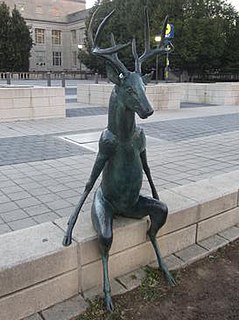 W
WScioto Lounge, or the Scioto Lounge deer sculptures, is a series of three bronze sculptures depicting anthropomorphic deer by Terry Allen, installed in Columbus, Ohio, United States. Two of the sculptures are installed in Genoa Park, and a third is installed on the Rich Street Bridge. The pieces were installed in 2014.
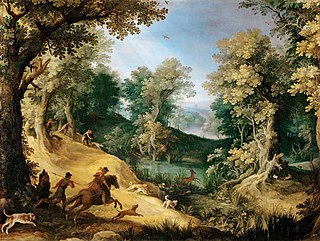 W
WStag Hunt is an oil on canvas painting by Flemish painter Paul Bril. It was probably painted in the 1590s, and is currently housed at the Louvre in Paris. The painting was once part of the collection of Louis XIV.
 W
WThe Stag Hunt mosaic is a mosaic from a wealthy home of the late 4th century BC, the so-called "House of the Abduction of Helen", in Pella, the capital of the Macedonian Kingdom. It bears the signature of the Ancient Greek artist Gnosis, of whom very little is known. It is now located in the Archaeological Museum of Pella, Central Macedonia, Greece.
 W
WStory Monument is a public artwork by American artist William Galloway, located at the intersection of State Road 135 South and Elkinsville Road in Story, Indiana, United States. Story Monument was originally surveyed as part of the Smithsonian's Save Outdoor Sculpture! survey in 1993. The monument is a tribute to the economy of Story.
 W
WThe Swimming Reindeer is the name given to a 13,000-year-old Magdalenian sculpture of two swimming reindeer conserved in the British Museum. The sculpture was made in what is now modern-day France by an unknown artist who carved the artwork from the tip of a mammoth tusk. The sculpture was found in two pieces in 1866, but it was not until the early 20th century that Abbé Henri Breuil realised that the two pieces fit together to form a single sculpture of two reindeer swimming nose-to-tail.
 W
WThe Triptych of Temptation of St. Anthony is an oil painting on wood panels by the Early Netherlandish painter Hieronymus Bosch, dating from around 1501. The work tells the story of the mental and spiritual torments endured by Saint Anthony the Great, one of the most prominent of the Desert Fathers of Egypt in the late 3rd and early 4th centuries. The Temptation of St. Anthony was a popular subject in Medieval and Renaissance art. In common with many of Bosch's works, the triptych contains much fantastic imagery. The painting hangs in the Museu Nacional de Arte Antiga in Lisbon.
 W
WValley of the Yosemite is a painting by Albert Bierstadt that was completed in 1864. Initially associated with the Hudson River School, Bierstadt rose to prominence for his paintings of the Rocky Mountains, which established him as one of the best painters of the western American landscape. His later paintings of Yosemite were also received with critical acclaim and public praise.
 W
WThe Vision of Saint Eustace is a painting by Annibale Carracci, showing saint Eustace and his vision of a crucifix between the horns of a stag whilst out hunting. The saint is set in one of the first landscapes by either of the Carracci brothers, showing how he was influenced by Venetian landscape painting until about 1598 after a stay in the city in 1587 and 1588. Specific influences include Titian's Penitent Saint Jerome (Louvre) and the naturalism of Jacopo Bassano. Critics argue the composition is based on two prints by Cornelis Cort, a Flemish printer - Penitent St Jerome and The Vision of Saint Eustace. These prints were in turn based on ideas by the Lombard painter Girolamo Muziano, who was also influenced by Venetian models. The dogs and some other details are drawn from Saint Eustace, an engraving by Albrecht Dürer of the same subject.
 W
WThe Vision of Saint Eustace is a painting by the early Italian Renaissance master Pisanello, now in the National Gallery in London. The date of the work is unknown and has been assigned by various scholars to different points in Pisanello's career, but the National Gallery's website currently dates it to "about 1438–42".
 W
WThe Wounded Deer is an oil painting by Mexican artist Frida Kahlo created in 1946. It is also known as The Little Deer. Through The Wounded Deer, Kahlo shares her enduring physical and emotional suffering with her audience, as she did throughout her creative oeuvre. This painting in particular was created towards the end of Kahlo's life, when her health was in decline. Kahlo combines pre-Columbian, Buddhist, and Christian symbols to express her wide spectrum of influences and beliefs.
 W
WThe Wounded Table is an oil painting by Mexican artist Frida Kahlo. Although lost in 1955, three photos of this painting were taken between 1940 and 1944. The painting was first displayed in January 1940 at the International Surrealism Exhibit at Inés Amor's Gallery of Mexican Art in Mexico City, and a replica is currently displayed in the Kunstmuseum Gehrke-Remund, Baden-Baden, Germany. The painting was last exhibited in Warsaw in 1955, after which it disappeared, and is the subject of an ongoing international search.